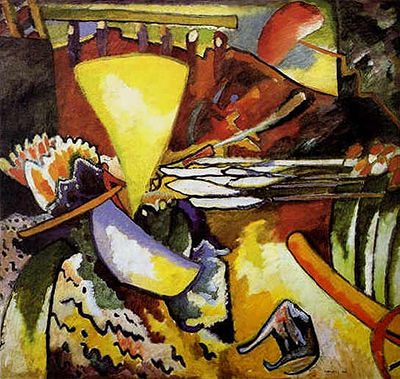Kandinsky produced a number of additions to his series of improvisations in 1910, with this version now being located at the Russian Museum in St Petersburg.
Interpretation is a real challenge to much of this series, for us at least. We see great shapes and objects thrown around in a chaotic fashion, but will little connection to reality, as far as we can see. Perhaps, after a more careful observation, there are figures walking across the top of the canvas. They resemble the artist's method of representing people during this period of his career, so that seems a viable assumption. There is also some sort of small creature at the bottom of the piece. The rest feels organic in some way, as if inspired by the artist's natural surroundings and so perhaps this is a landscape with hills at the top, and plants and trees in the foreground.
Improvise, compose and impress, those are the techniques used by Kandinsky to create three separate bodies of work which ultimately ran parallel of each other. How could the mind produce art from its deepest recesses, if it turned its back on reality? And what would be the output? These questions inspired the artist to research his own mind and see what could occur from a new way of thinking about art. The writings of Freud had also impacted some of this movement within art, where he himself would start to teach others about the unconscious mind and that would inspire many Dali paintings, for example. Although the individual elements of his improvisation series are not particularly well known, the overall strand of work is considered important as part of Kandinsky's movement towards a truly abstract language in which he would continue to work for many years.
When we think about how the artist was attempting to look deep into the recesses of his own mind for inspiration, even artistic direction, it is therefore unsurprising that some a chaotic body of work would appear. It is hard to determine how much really came from this, and how much was intended, even unknowingly. Howvever, the process was important and influential on a number of others during the early 20th century. One may struggle to find any real detail from this series, something that we can confidently identify, but often that was not the intention. New ideas would always take time to be moulded into something consistent and Kandinsky was essentially experimenting openly at this stage, publishing the results as completed paintings and later through his books on art theory.




